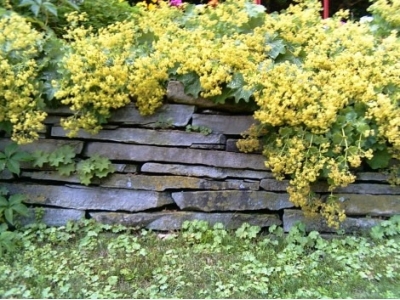How to Grow Ladys Mantle Flowers

Learn more about growing Lady's Mantle flowers.
Like peonies and lilacs, lady’s mantle is an old-fashioned plant that deserves a revival. Hardy in U.S. Department of Agriculture plant hardiness zones 4 through 7, lady’s mantle flowers (Alchemilla mollis) have a rounded, mounding form and charming scalloped leaves. The leaves are large, deep green and velvety. They’re especially lovely after a rain when the leaves collect the raindrops, of first thing in the morning when they’re covered in dew.
In addition to its pleasing form and leaves, lady’s mantle produces clusters of small, chartreuse flowers in spring and early summer. Lady’s mantle grows to 18 inches tall and 2 feet wide, depending on the variety. It grows easily in the right conditions – fertile, moist soil and partial shade. In dry, hot conditions, the leaves become faded and ragged. Plant lady’s mantle along walkways or as a border plant in a shade garden.
Planting Lady’s Mantle Flowers
Lady’s mantle grows easily from seed, divisions or nursery transplants. Plant a few plants in the garden and you’ll soon have more than you need. Sow seeds in the garden in the fall or in early spring, or you can start them indoors 6 to 8 weeks before the last frost. Keep the seed trays moist and plant them outdoors when the plants stand 4 inches tall. Space transplants 12 inches apart. They’ll fill in quickly to make a dense ground cover.
Amend the soil before planting with compost or manure and dig in a slow-release 10-10-10 fertilizer at a rate of ½ cup per 100 square feet. Water the plants at least weekly as they become established to keep the soil evenly moist, but not soggy. Mulch the ground with 2 inches of wood chips, which suppresses weed growth and also conserves moisture.
One frequent problem with lady’s mantle is its enthusiastic self-sowing. In moist, shady areas, the plants can quickly become invasive. Deadhead the flowers as soon as they fade to minimize this problem and pull up any plants that grow in unwanted areas.
Divide lady’s mantle every two to three years to prevent overcrowding and to rejuvenate growth. Dig up the plants and cut them in three pieces with a shovel or knife. Replant the divisions – or give them away if you have more than you need.
Lady’s Mantle Problems and Pests
Lady’s mantle rarely suffers from disease or pest problems. The most common problem – leaf scorch – is caused by too much sun and heat and not enough water. Address those issues and you’ll likely have success.
Lady’s Mantle Cultivars Worth Trying
Common lady’s mantle is the species plant and the one you’re most likely to find in nurseries. It grows 12 to 24 inches tall.
‘Auslese’ has deep chartreuse flowers.
‘Red Mantle’ has red stems that contrast nicely with the chartreuse flowers. Its leaves are blue-green.
‘Robusta’ is a cold-hardy, long-lived variety.
‘Senior’ is the one to choose if you want a compact ground cover.
Related news
 How to Grow Foxglove (Digitalis)
How to Grow Foxglove (Digitalis) If you dream of a romantic, old-fashioned garden, then foxgloves are sure to top your list. These plants produce spikes of bell-shaped flowers atop low mounds
 How to Grow Cedar Trees
How to Grow Cedar Trees These trees have a similar form and use, but their growing conditions vary and they do not belong to the same family.
 How to Get Rid of Invasive English Ivy
How to Get Rid of Invasive English Ivy In its native habitat, it acts as an important link in the food chain for the local population of birds and insects. Its ability to vine and climb is one of its